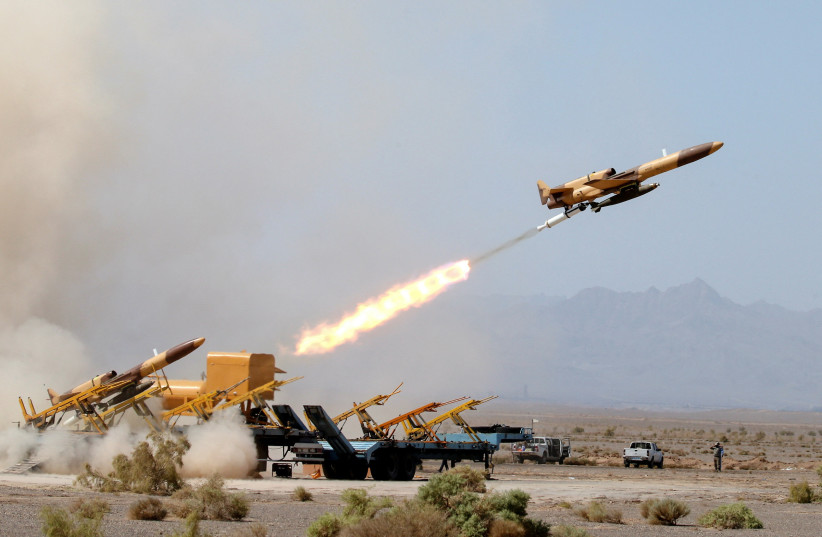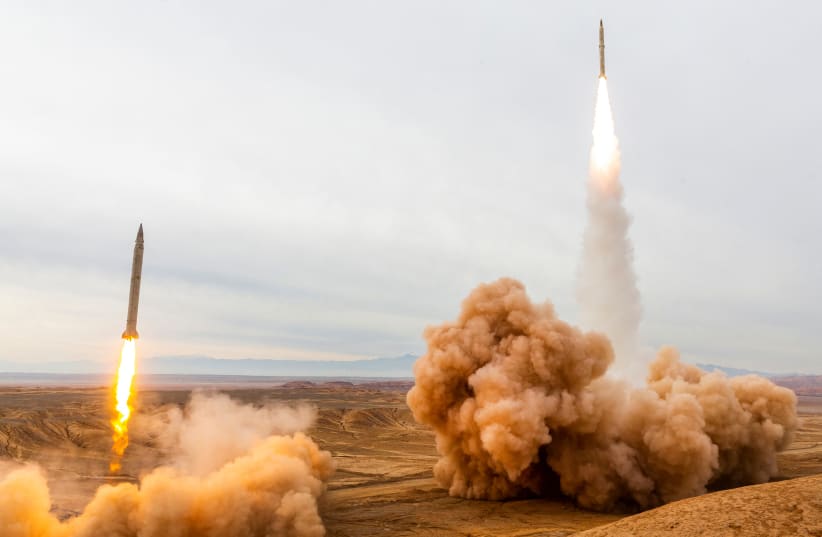In an incredible act of admission that shows Iran does not fear any reprisal, Iran admitted last week that it fired 73 surface-to-surface missiles at Kurdish groups in Iraq. It also used “dozens of drones.” Since then Iran has continued to bombard Kurdish groups in Iraq, for two weeks in a row.
This is clearly an attempt to distract from protests at home. Iran is also brutally crushing protests.
Iran is clearly upping its threats to the region through the admission that it used missiles and drones against Kurdish groups in Iraq. It shows that the regime in Tehran believes it can basically test its missiles and drones by attacking Kurdish opposition groups in Iraq. It knows these groups are defenseless and that Iran can quietly plan the attacks and practice using drones, missiles and artillery in combined operations.
The videos that Iran released on September 28 showed it using two types of missiles in its operations and Iran claimed to use dozens of drones as well. It’s possible the missiles were the Fateh 360 type Iran tested earlier this month. What matters is not just the type but also that Iran is becoming more proficient in the use of drones and missiles together.
Iran also sent up a Mohajer-6 drone and took surveillance video of the areas it struck. The US grew so concerned about the Mohajer-6 that it sent an F-15 to shoot down the Iranian drone.


Iran is not shy about showing off its capabilities. It published videos of the Iranian rockets being fired and also showcased it firing 122mm grad rockets from a truck. Iran also showed its soldiers preparing for the operation and artillery in action.
It also published video of the strikes taken from its drone. Around 73 ballistic missiles were fired, Iran said. Numerous targets were struck across northern Iraq’s Kurdistan region.
Lessons for Israel
What does this mean for Israel and for Iran’s threats in the region?
Iran arms militias in Iraq with the same weapons it used to attack Kurds. It arms militias in Syria and also Hezbollah with similar munitions. It has also helped Hamas increase the range of its rockets and stockpile drones. It has helped the Houthis in Yemen do the same. Therefore Iran’s attacks against the Kurdish groups in Iraq should not be seen in a vacuum but as part of the wider Iranian threats in the region.
Iran’s current wave of attacks and threats has increased in the last five years.
In 2018 Iran tried to move an air defense system to Syria and it has continued trying to move missiles, rockets, drones and precision-guided munitions to Syria.
Iran launched a drone at Israel in February 2018 from Syria. Iran attacked Saudi Arabia using drones and cruise missiles in 2019.
In the same year, it sent a Hezbollah drone team to threaten the Golan. Iran has attacked a ship in the Gulf of Oman using a drone in July 2021, and it has tried to attack Israel with drones flown from Iran and Iraq over the last two years. These are increasingly sophisticated operations.
It is likely that Iran not only trained drone operators from around the region but that its tactics used to terrorize northern Iraq and attacks Kurdish groups — as well as US forces in Iraq and Syria — are models for future attacks on Israel.
What that means is that while Iran has so far resorted to small probing attacks, like the February 2018 drone incident or the May 2021 drone incident; it is growing in its capacity and willingness to threaten Israel. Hezbollah’s threats against the offshore Karish gas platform near Israel’s shores is one example.
Iran-Russia drone axis
Another alarming aspect of the Iranian drone threat that is manifesting itself in attacks like the one in Iraq is the Iran-Russia drone axis.
Russia sent a delegation to Iran earlier this year to check on Iran’s drone arsenal. Iran has increased the types, ranges and precision of its drones in recent years. Russia is now using the Iranian-style Shahed 136 in attacks on Ukraine.
The US has sanctioned Iran for exporting and manufacturing these drones for Russia. It is clear now that Iran’s missiles and drones cannot be ignored as threat that only impacts the Middle East. They are now moving these weapons further from home and providing their weapons with ranges increasing to thousands of miles.
Israel has the air defenses to stop Iran’s drones and Israel and the US already coordinate on interdicting Iran’s operations in Syria.
In addition, Israel and the Gulf states are working on air defense cooperation both through potential sales of Israeli systems and also wider cooperation with US Central Command. What should be learned from the attacks on northern Iraq is that Iran is practicing and perfecting its use of drones and missiles and that it will soon launch wider attacks in the region with these systems.
